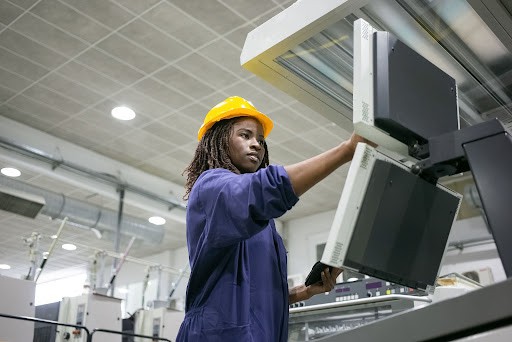
Both types of manufacturing methods are often used in different stages of product development and both types of manufactured parts are often found together in final assemblies.
Parallels aside, there are major differences to why and when a part would be manufactured using subtractive vs. additive manufacturing. So, let’s look at some of them now.
Additive Manufacturing vs. Subtractive Manufacturing: The Biggest Difference
Additive
Additive manufacturing often uses a 3D printer to deposit materials and bond them together, one layer at a time, to create a part.
At its simplest, manual additive manufacturing can be compared to stacking circular ropes of clay on top of each other to make a bowl. The ropes are stacked in layers on top of each other, adding layers that eventually take shape to form the bowl, bonded through the application of tools, pressure, and heat.
Most often used for aerospace manufacturing, additive manufacturing is currently a rapidly growing manufacturing segment with an expected annual growth rate of 14.8% from 2020 to 2027.
Subtractive
Subtractive manufacturing is just the opposite – it often uses cutting tools guided by Computer Numerical Control (CNC) to cut away at a solid and removes the excess material to create a part. The simple manual example for subtractive manufacturing would be chiselling a bowl out of a solid chunk of clay.
| Want to Learn More About CNC Machining? Take a Look at These Blogs. |
In these simplified scenarios it is easy to tell the difference between the types of manufacturing, but difficult to know why you might choose one over the other.
In the real-world of automated manufacturing, factors such as raw material type, part complexity, part end-use and production size are what determine the advantages and disadvantages to using additive vs. subtractive manufacturing.
Subtractive Manufacturing vs. Additive Manufacturing: When They Work Best
Subtractive Manufacturing Processes Are Best For:
- Precision goods with tight tolerances
- Parts that are difficult to mould or cast
- Parts that need a certain type of finish
- Parts made from metals
- High-volume production runs
- Parts that will be under stress and strain
Additive Manufacturing Processes Are Best For:
- Designing and prototyping
- Small, complex parts
- Parts in the early stages of development that need versatility
- Parts made of less expensive plastics
These are major differences in when you might use additive vs subtractive manufacturing are shown above. Now, let’s take a look at why you would choose additive vs subtractive manufacturing.
| Create The Parts You Need Without Overspending or Sacrificing Quality |
Additive Manufacturing vs. Subtractive: Why They Work
Generally speaking, additive manufacturing can be more costly, but it is also more versatile. While the cost of 3D printers depends on size, they are able to produce a myriad of complex parts, depending on the materials used.
This is why additive manufacturing processes are good for prototyping. Because, if you want to see what your design looks like with a slight tweak to it, printing variations is a simple matter.
Smaller, less expensive 3D printers usually handle plastic parts, while larger, more expensive industrial-sized 3D printers are able to handle heavy-duty metals.
Since 3D printed parts are produced by adding materials on top of each other, this layering can be visually noticed as striations in the newly-printed part. These parts may then require additional cleaning and finishing before they are ready for end-use. This also explains why additive manufacturing isn’t as logical to use for precision goods or to create parts that need certain surface finishes.
On the other hand, subtractive manufacturing processes often employ CNC machining to accurately and precisely cut parts, including the ability to produce unique finishes without any further processes needed.
Subtractive manufacturing uses computer-controlled machining with the ability to implement special tooling that handles hard metals without needing an entirely new setup.
The possibility of using hybrid systems that leverage the flexibility, complexity and inexpensive alternatives present in additive manufacturing while keeping the precision, finishing, strength and production volume of subtractive manufacturing is sure to shape the future of manufacturing in general.
Subtractive vs Additive Manufacturing: Making the Choice
Or more simply, let the experts inform your decision based on the type of parts you need. It may be that a mixture of both processes could be the best solution.
Let’s identify the most efficient and cost-effective way to create the parts you need together. Talk to us today and put your supply chain into the fast, high-quality lane it needs to be in.